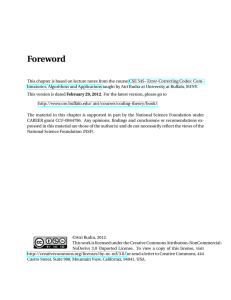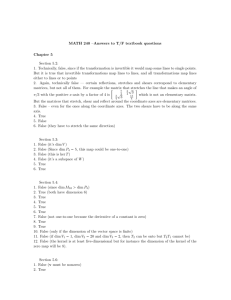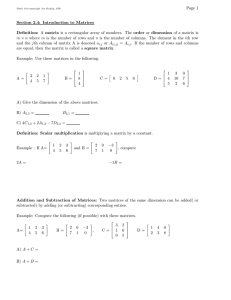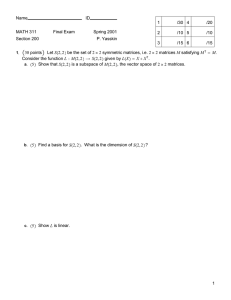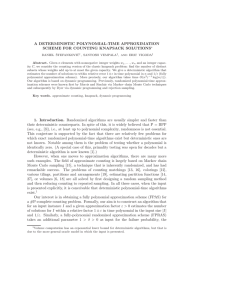A Note on Matrix Rigidity
advertisement
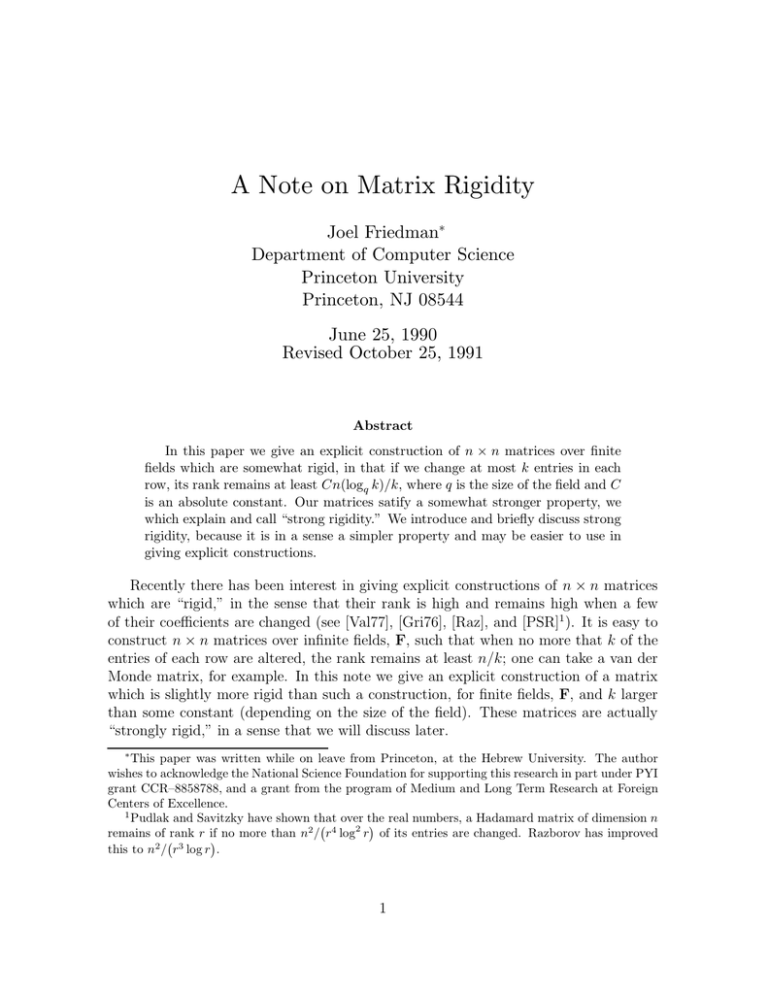
A Note on Matrix Rigidity
Joel Friedman∗
Department of Computer Science
Princeton University
Princeton, NJ 08544
June 25, 1990
Revised October 25, 1991
Abstract
In this paper we give an explicit construction of n × n matrices over finite
fields which are somewhat rigid, in that if we change at most k entries in each
row, its rank remains at least Cn(logq k)/k, where q is the size of the field and C
is an absolute constant. Our matrices satify a somewhat stronger property, we
which explain and call “strong rigidity.” We introduce and briefly discuss strong
rigidity, because it is in a sense a simpler property and may be easier to use in
giving explicit constructions.
Recently there has been interest in giving explicit constructions of n × n matrices
which are “rigid,” in the sense that their rank is high and remains high when a few
of their coefficients are changed (see [Val77], [Gri76], [Raz], and [PSR]1 ). It is easy to
construct n × n matrices over infinite fields, F, such that when no more that k of the
entries of each row are altered, the rank remains at least n/k; one can take a van der
Monde matrix, for example. In this note we give an explicit construction of a matrix
which is slightly more rigid than such a construction, for finite fields, F, and k larger
than some constant (depending on the size of the field). These matrices are actually
“strongly rigid,” in a sense that we will discuss later.
∗
This paper was written while on leave from Princeton, at the Hebrew University. The author
wishes to acknowledge the National Science Foundation for supporting this research in part under PYI
grant CCR–8858788, and a grant from the program of Medium and Long Term Research at Foreign
Centers of Excellence.
1
Pudlak and Savitzky have shown that over the
real numbers, a Hadamard matrix of dimension n
2
2
4
/
r
log
r
of its entries are changed. Razborov has improved
remains of rank r if
no
more
than
n
2
3
this to n / r log r .
1
Theorem 1 For any constant C1 > 0 there is a constant C2 > 0 such that the following
holds. Let F be a finite field of q elements. Let A be an n × n matrix such that the first
n/2 rows are the basis of a linear error-correcting code in F n of minimum distance
≥ C1 n. If B is any n × n matrix over F with at most k non-zero entries in each row,
where k ≤ n/C2 , then we have
rank(A + B) ≥
n logq k + logq (q − 1) .
C2 k
In the above theorem it is the “logq k” as opposed to the “logq (q − 1)” which is of
interest. We have included the “logq (q − 1)” to remark that when q → ∞ with fixed
n and k, the construction does not completely degenerate.
The above matrices satisfy a stronger property, which we call “strong rigidity.”
After proving this theorem we define and discuss strong rigidity, because it is somewhat
easier to work with and may be a useful point of view in constructing other explicit
examples.
We recall that there are many types of explicitly specified codes, which for any
value of q give a sequence of n’s and a code for each such n of dimension n/2 and
minimum distance C1 n with C1 independent of q and n (one can take Justesen codes
or Goppa codes, see respectively [vL82] and [vdGvL88]). Thus the above theorem, for
any value of q and many of n, gives matrices rigid in the above sense.
Proof The first n/2 rows of A represent vectors v1 , . . . , vn/2 which are a basis of linear
code (subspace) C ⊂ Fn of minimum distance ≥ C1 n. Let b1 , · · · , bn/2 be the first n/2
rows of B. If the rank of the matrix consisting of the first n/2 rows of A + B is t, then
this is just to say that
E≡
w = (w1 , . . . , wn/2 ) ∈ Fn/2
n/2
X
wi (vi + bi ) = 0
i=1
(here 0 is the origin in Fn ) satisfies
dim E =
n
− t.
2
Since E is an (n/2) − t dimensional subspace of Fn/2 , we can find a non-zero element
w ∈ E of weight r for any r satisfying
Hamming ball of radius r/2 in Fn/2 ≥ q t ,
or more crudely,
!
n/2
(q − 1)r/2 ≥ q t .
r/2
2
(1)
But for such a w we have
n/2
X
wibi ∈ C − {0},
i=1
and so such an r must satisfy rk ≥ C1 n. So taking r0 = dC1 n/ke − 1, equation 1
cannot hold for r = r0 , that is to say that t is bounded below by
"
t ≥ logq
!
#
!
n/2
n/2
r0
n (q − 1)r0 /2 ≥ logq
+ logq (q−1) ≥
logq k+logq (q−1) ,
2
C2 k
r0 /2
r0 /2
for large enough C2 , also assuming k ≤ n/C2 , where we have estimated
!
logq
n/2
≥ logq
r0 /2
"
n r0
−
2
2
#
r0 /2 (r0 /2)
r0 /2
≥
n
logq k .
C2 k
2
Definition 2 C ⊂ F n is (k, t)-strongly rigid if every subspace B spanned by c = dim C
vectors b1 , . . . , bc , each of weight ≤ k, has
dim(B ∩ C) ≤ dim C − t.
(2)
Glancing at the proof of theorem 1 shows that matrix A is actually (k, t)-strongly rigid
with t = n logq k/(C2 k). Strong rigidity is a simpler property to check, in the sense
that we do not care about the precise relations between a basis for C and of one for B.
Therefore, as in theorem 1, we hope that it may be easier to work with strong rigidity
to give explicit constructions.
To compare strong rigidity to the usual notion of rigidity, we’ll say that an n × n
matrix A is (k, t)-rigid if whenever no more than k entries in each row of A are altered,
then A’s rank remains at least t. It is easy to see (and well-known) that if A is a
“random” n × n matrix in an infinite or sufficiently large field, F, then with high
probability2 A will be (k, t)-rigid with any t ≤ n − (nk)1/2 .
While we cannot assert so large a value of t for the existence of strongly rigid
matrices, we can obtain existence for a value of t which is interesting for some of the
intended applications of rigid matrices.
Theorem 3 Let k, n be integers with k ≤ n/2 and (for simplicity) n even. Then over
any finite field, F, there exists a (k, t)-strongly rigid code C ⊂ F n of dimension n/2,
for any t with
n k logq n
n 1
t ≤ − k logq − −
,
8 2
k
4
4
where q is the size of F. The same holds for any infinite field, where in the above
equation we substitute 0 for the two occurrences of logq ( ), and where we require strict
inequality. If we substitute “n/10” for the “n/8” in the above equation for t, then any
n × n matrix over F is (k, t)-strongly rigid with “high probability.”
2
If F is infinite, the entries of A should be chosen from a distribution which has each field element
weighted sufficiently small.
3
Proof This is, as usual, an easy counting argument (in the case of infinite fields one
counts dimensions). For any subspaces B, C of Fn with
dim B = dim C,
dim(B ∩ C) ≥ dim C − t,
(3)
it is easy to see that there exist v1 , . . . , vt ∈ Fn and `1 , . . . , `t ∈ (Fn )∗ (i.e. the dual of
Fn as an F-vector space) such that
n
o
C = v ∈ sp hB, v1 , . . . , vt i `i (v) = 0 ∀i ,
(4)
where sp h i denotes the linear span. To see this, notice that equation 3 also implies
dim(B + C) ≤ dim C + t = dim B + t ;
hence we can choose vi so that
B + C = sp hB, v1 , . . . , vt i
and then choose `i so that equation 4 holds.
Equation 4 shows that to every code C of dimension n/2 which is not (k, t)-strongly
rigid there corresponds (at least one collection of) a B generated by n/2 vectors of
weight ≤ k and vectors vi and (dual) vectors `i as above. In the case of F finite, the
number of vectors of weight ≤ k is
!
≤ n(q − 1)
k
n
k
(assuming k ≤ n/2), and so the total number of collections (B, {vi }, {`i }) is bounded
by
"
!#n/2
k n
≤ n(q − 1)
q 2nt .
(5)
k
On the other hand, the total number of subspaces of Fn of dimension n/2 is
(q n − 1)(q n − q) · · · q n − q (n/2)+1
(q n/2 − 1)(q n/2 − q) · · · q n/2 − q (n/2)−1
≥
qn − 1
q n/2 − 1
!n/2
> q n/2
n/2
It follows that a (k, t)-strongly rigid C of dimension n/2 exists provided that
"
q
in particular, using
n
k
n2 /4
!#n/2
≥ n(q − 1)k
n
k
q 2nt ,
≤ (n − k)k /k k ,
t≤
n 1
n k logq n
− k logq − −
.
8 2
k
4
4
4
.
Also, if we replace the n/8 in the above by n/10, then a randomly chosen C of dimension
n/2 has probability ≤ n−n/40 of not being (k, t)-rigid.
If the field is infinite, then the dimension of the set of tuples (B, {vi }, {`i}) as an F
variety3 is
kn
+ 2nt.
2
This, of course, is the q → ∞ limit of logq of the expression in equation 5. The same
goes through for the set of all C, i.e. subspaces of dimension n/2 in Fn , meaning that
one counts its dimension as an F variety (and gets the q → ∞ limit of log q of the
previously derived expression for finite fields). Therefore we get the aforementioned
results, except that we need strict inequality in the inequality for t, and that when we
use n/10 instead of n/8, “high probability” means occurs as a subvariety of codimension
≥ bn/40c.
2
J. Håstad has pointed out to me that the construction given in theorem 1 will,
in general, be no better that (k, t)-rigid for t proportional to n logq k/k; that is, by
starting with n/2 random vectors {bi } of small weights, choosing a random subspace
of Fn of dimension t, and choosing n/2 random vectors in this subspace, {ui}, one
gets (many) matrices A as in the theorem which are not (k, t)-rigid for appropriate t
of order n logq k/k (i.e. where A’s first n/2 rows are {bi + ui }).
The author wishes to thank A. Wigderson, J. Håstad, and A. Razborov for helpful
discussions and comments.
References
[Gri76]
D.Y. Grigorjev. Notes of the Leningrad Branch of the Steklov Mathematical
Institute of the Academy of Science of the USSR, 60:38–48, 1976.
[PSR]
Pudlak, Savitzky, and A. Razborov. Observations on rigidity of Hadamard
matrices. Personal Communication.
[Raz]
A. Razborov. On rigid matrices. Problems of Pure and Applied Mathematics (Literal Translation from Russian). to appear.
[Val77]
L.G. Valiant. Graph-theoretic arguments in low-level complexity. Technical
Report, University of Edinburgh, 1977. Computer Science Report 13-77.
Also in Proc. 6th Symp. on Mathematical Foundations of Computer Science, Tratranska Lomnica, Czechoslovakia 1978.
3
Throughout this paragraph we will, by a slight abuse of terminology, use “F variety” to mean
“algebraic set over F.” We do not require these sets to be irreducible.
5
[vdGvL88] G. van der Geer and J. van Lint. Introduction to Coding Theory and
Algebraic Geometry. Birkhäuser Verlag, Boston, 1988.
[vL82]
J. van Lint. Introduction to Coding Theory. Springer-Verlag, New York,
1982.
6
